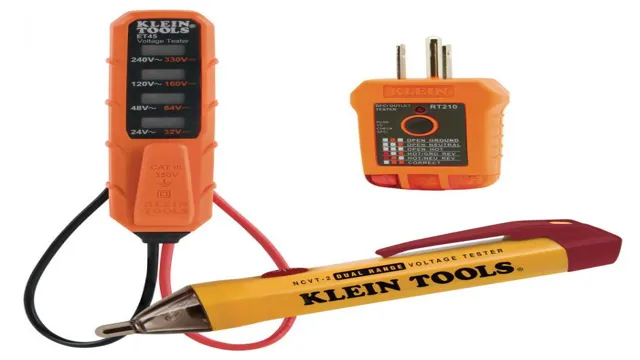Are you an electrician or DIY enthusiast who often gets confused between circuit testers and voltage testers? You’re not alone! Many people tend to mistake these two devices for each other, but they serve different purposes. Circuit testers and voltage testers may look similar, but they are designed to detect different electrical issues. Circuit testers check for the presence of electricity in a particular circuit or wire, while voltage testers measure the voltage or potential difference between two points in electrical systems.
Think of them as doctors with different specialties – a circuit tester would be a cardiologist who specifically deals with heart-related issues, while a voltage tester would be a general practitioner equipped to diagnose different medical problems. To get a clearer understanding of what sets these two electrical testing tools apart, let’s dive deeper into their individual functions, how they work, and when to use them. So, let’s start with the basics to help you differentiate between circuit and voltage testers in your next electrical project.
Definitions
Many people wonder if a circuit tester and a voltage tester are the same thing, but the answer is no. While both tools are used to test electrical circuits, they serve different purposes. A circuit tester is used to check for the presence of electricity in a wire or device, while a voltage tester measures the amount of voltage in a circuit.
Circuit testers typically have a series of lights or an audible alarm that indicates the presence of electricity, while voltage testers display the voltage level on a digital screen. It’s important to use the right tool for the job to ensure safety and accurate readings. So, if you’re wondering about the difference between a circuit tester and a voltage tester, just remember that they have distinct functions, and it’s important to choose the right one for your needs.
What is a Circuit Tester?
A circuit tester is a versatile tool that is used to check the electrical conductivity in a circuit. It is an essential tool that is regularly utilized by electricians, mechanics, and DIY enthusiasts to locate and repair faults in wiring, fuses, and switches. The tester is equipped with a probe and a visual or audio alert that tells you whether or not the power is flowing in the circuit.
There are many types of circuit testers, from simple voltage detectors to more advanced multi-meter testers. However, all circuit testers serve the same purpose of checking the continuity and voltage in a circuit. A circuit tester is a valuable addition to any toolbox, as it can save you time and effort when troubleshooting electrical problems.

What is a Voltage Tester?
A voltage tester is an electrical device that measures the amount of voltage present in a particular circuit or electrical appliance. It is a crucial tool that is used by electricians to ensure the safety of electrical systems and appliances by testing for any potential electrical hazards. The voltage tester works by detecting the electrical potential difference between two points in a circuit and indicating it through an LED or audible alarm.
This device comes in different types, including digital multimeters, circuit testers, and non-contact voltage testing pens. A voltage tester is essential for anyone working with electricity to check circuits and electrical appliances. It helps to prevent accidents and ensure the safety of people and property.
Always make sure to use a voltage tester before working with any electrical equipment to avoid any potential electrical hazards.
How They Work
Many people often wonder whether a circuit tester is the same as a voltage tester. While they both serve a similar purpose, they are not the same thing. A circuit tester is designed to check for continuity in a circuit, indicating if the current is flowing properly or not.
On the other hand, a voltage tester is used to test the presence of voltage in a circuit and measure its strength. This is important since voltage can be deadly if not handled properly. It’s essential to use the right tool for the job as it can be dangerous to assume they’re interchangeable.
When working with electricity, a voltage tester should always be used to check for the presence of voltage before continuing. So, while they may seem similar, it’s important to understand the distinction between circuit testers and voltage testers.
Circuit Tester Functionality
Circuit tester functionality can be a bit confusing, but it’s essential to understand how they work to ensure your electrical projects are safe and functional. Simply put, circuit testers work by detecting the presence of voltage in a circuit. When you touch the tester to a wire or outlet, a light or sound will indicate the presence of voltage.
Some testers are more advanced and can indicate the specific voltage level, polarity, and even identify specific wiring issues. Circuit testers are particularly useful for identifying poorly grounded outlets or faulty wiring that can lead to safety hazards or equipment damage. So, whether you’re an electrician or a DIY enthusiast, having a reliable circuit tester in your toolbox is a must-have to help you ensure your projects are safely and correctly wired.
Voltage Tester Functionality
When it comes to checking the voltage of electrical systems, a voltage tester is an essential tool to have. But how does it work? Well, there are a few different types of voltage testers available, but the basic principle is the same. A voltage tester consists of two probes, a positive and negative, which are used to make a connection with the electrical circuit being tested.
The tester will then either light up or produce a sound or both to indicate the presence of voltage. Some testers even have a digital display that shows the exact voltage level. One important thing to remember is to always test the tester itself before using it, to ensure it is functioning correctly and safely.
Using a voltage tester incorrectly can be dangerous, so be sure to read the instructions and use caution. With proper use, a voltage tester can be a valuable tool for identifying electrical issues and keeping yourself safe.
Which One to Use
If you are not an expert in electrical work, you might be wondering whether a circuit tester is the same as a voltage tester. Let me tell you that, although they seem similar, they have different purposes. A voltage tester measures the presence or absence of voltage in an electrical system, while a circuit tester checks for the continuity of the circuit.
In other words, a voltage tester informs you if there is power in a wire, while a circuit tester verifies that the power flows properly through the wire. To make it even simpler, a voltage tester is mostly used for safety reasons, while a circuit tester is used to troubleshoot electrical problems. Bottom line, if you need to fix an electrical issue, you might need both, but if you just want to check if a wire is safe to touch, a voltage tester will suffice.
When to Use a Circuit Tester
When it comes to using a circuit tester, there are a few different types to consider. The most common ones include a non-contact voltage tester, a two-wire voltage tester, and a three-wire circuit tester. A non-contact voltage tester is great for detecting voltage without needing to make direct contact with any wires, making it a safe choice for identifying live wires.
However, it’s not as precise as a two or three-wire circuit tester, which can provide more detailed information about voltage and continuity. A two-wire voltage tester is useful for simple checking of electrical circuits, while a three-wire circuit tester is more advanced and can help identify problems with faulty wires or connections. The right circuit tester for your needs will depend on the specific job and your level of experience.
When to Use a Voltage Tester
If you’re working with electrical equipment, it’s always best to error on the side of caution and use a voltage tester to ensure there are no active electrical currents. When it comes to choosing the right tester, there are a few different options available. The first is a non-contact voltage tester, which allows you to check for the presence of electrical current without making contact with the wires or terminals.
This type of tester is ideal for quick and easy checks and is often quite affordable. Another option is a multimeter, which can be used to measure voltage, current, and resistance. These testers are more in-depth and require more skill to use, but they offer a broader range of functions.
If you’re just starting out, a non-contact tester is probably your best bet, but as you become more experienced, a multimeter may become a valuable tool in your kit. Whichever tester you choose, be sure to use it properly and always double-check your results to ensure your safety.
Conclusion
In the electrical world, a circuit tester and voltage tester may seem interchangeable, but they are not one and the same. A circuit tester is like the mechanic who checks the engine, while a voltage tester is like the doctor who checks the pulse. Both are crucial in diagnosing issues, but they require different sets of skills and tools.
So, next time you’re troubleshooting, make sure to use the right tester for the job – or risk sparking a shocking surprise!”
FAQs
What is a circuit tester used for?
A circuit tester is used to test the continuity and presence of voltage in an electrical circuit.
What is a voltage tester used for?
A voltage tester is used to test the presence of voltage in an electrical circuit.
How are a circuit tester and a voltage tester different?
While both testers are used to detect the presence of voltage, a circuit tester is also able to test for continuity and can be used to identify specific issues in a circuit.
Can a circuit tester be used as a voltage tester?
Yes, a circuit tester can be used to detect the presence of voltage in a circuit, but it may not be as accurate as a dedicated voltage tester.
What safety precautions should be taken when using a circuit tester or voltage tester?
Always use proper personal protective equipment (PPE) such as gloves and safety glasses. Make sure the circuit is turned off before testing and test the tester on a known power source before using it on an unknown circuit.
How do you use a voltage tester?
To use a voltage tester, first turn off the power to the circuit being tested. Then, touch the tip of the tester to the wires or terminals being tested. The tester will light up or make a sound if voltage is present.
Can you use a circuit tester or voltage tester on live electrical circuits?
No, it is not recommended to use a tester on live circuits. Always turn off the power before testing and follow proper safety precautions.






